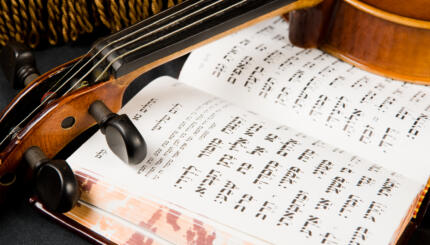No Psalm is better known or recited more frequently than Psalm 145, known by its liturgical title Ashre. Since Gaonic times it has been recited thrice daily–twice in the morning service introducing sections of the service, and once as a prelude to the afternoon service. Despite its frequency, its meaning has eluded most readers, who fail to understand its rhetorical structure. By laying bare the relationship between form and content, theme and structure, we are able to see how its rhetorical structure advances its program for the extension of divine sovereignty.
This liturgical piece is presented below in a manner that renders transparent its internal dynamic. The added Psalm verses, which are prefixed and suffixed to Psalm 145, are designated prologue and epilogue. Psalm 145 itself is designated the body.
Read the complete text of Ashrei here.
Comprised of 21 verses, the Psalm consists of four stanzas, introduced by a prelude, intersected by an interlude, and concluded with a postlude, which may be diagrammed as follows:

Help us keep Jewish knowledge accessible to millions of people around the world.
Your donation to My Jewish Learning fuels endless journeys of Jewish discovery. With your help, My Jewish Learning can continue to provide nonstop opportunities for learning, connection and growth.
Prelude: vv. 1-2
I: vv. 3-6
II: vv. 7-9
Interlude: v. 10
III: vv. 11-13
IV: vv. 14-20
Postlude: v. 21
The translation I have done reflects Ashre’s structure as well as its internal connections, while adhering closely to the Hebrew order and choice of terms. The Psalm’s theme of divine sovereignty is announced in the first line through the words, “my God the king.” Although there are other Psalms that proclaim “my king and my God,” only Psalm 145:1 uses the definite article for the apparent purpose of underscoring the exclusivity of divine rule.
Psalm 145 has its message of divine sovereignty broadcast in three stages to successively broader circles. Each stage is marked by the word “bless,” which crops up strategically in the second colon of lines 1, 10, and 21, the three lines that serve as prelude, interlude, and postlude. The prelude starts: “I bless Your name forever”; the interlude continues: “Your faithful ones bless you”; whereas the postlude climaxes: “all flesh shall bless His holy name forever and ever.”
The drive toward inclusiveness is reinforced by the envelope structure. By having the end formally echo the beginning, the Psalm paves the way from the “I bless” of the prelude to the “all flesh shall bless” of the postlude; both “forever and ever.”
God’s Greatness
Stanza I forms a quatrain on the subject of God’s greatness. Line 3 opens with great/greatness as line 6 concludes with greatness. Stanza II forms a triad on God’s goodness. Line 7 celebrates God’s abundant goodness as line 9 proclaims that God is good to all. By opening and closing with “great” and “good” the two stanzas converge to make the point that praise is generated by appreciating the link between divine greatness and goodness. Indeed, the juxtaposition of the two intimates what is made explicit in the next stanza, namely, that God’s goodness is an expression of His greatness.
Stanzas III (lines 11-13) and IV (lines 14-20) serve to advance the thesis of stanzas I and II through specification and concretization as in much of biblical parallelism. What is implicit in stanzas I and II becomes explicit in III and IV.
Thus the theme of sovereignty, intimated in stanza I through expressions of divine grandeur, is made graphic in stanza III. All the salient terms indicate divine strength and majesty such as “great,” “might,” “glorious,” “splendor,” “power.” This indication is intensified by the compounding of the following terms for such greatness:
1. “His greatness” (u-gedulato),
2. “and Your might acts” (u-gevuratekha),
3. “and Your wondrous things” (ve-divre nifla’otekha),
4. “and of the power of your awesome deeds” (ve-azuz norotekha),
5. “and your greatness[es]” (u-gedulotekha).
Stanza IV adduces cases of the mercies of God mentioned in stanza II, as signs of God’s divine reign. Hoping that perceiving the divine grandeur as refracted through a caring kingship will trigger the desire to acclaim God king, the psalmist anticipates all humanity joining in such an acclamation.
Each of the four stanzas forms a step in the escalation of praise. The first stanza (lines 3-6) underscores the inadequacy of only the psalmist praising every day. Not only is God, according to the psalmist, “extolled, blessed, praised, yea exceedingly praised,” His works are “lauded, declared, narrated, talked of, and recounted.” Nonetheless, however much “His greatness, mighty, wondrous, and awesome acts and deeds” are exalted, divine grandeur remains limitless.
The second stanza (lines 7-9) celebrates the extension of divine goodness to all. Line 8’s cluster of epithets of grace (hanun v’rahum…) resonates with echoes of the 13 attributes of Exodus 34:6 that were to become, if it had not already, a liturgical staple. Verse 8 reproduces the series of epithets of Exodus 34:6, except that it has u-gadol hesed (“abundant kindness”) instead of rav hesed (“abounding in kindness).
Stanza III is marked by the theme of kingship. As realizing God’s kingship induced the psalmist to bless God by pointing out how His acts are to be praised in stanza I, so in stanza III (lines 11-13), the faithful bless God, realize His kingship, and seek “to make His mighty acts known to humanity” (line 12). Stanza III thus advances toward the end (in both senses) of the psalm that all flesh join in such blessing.
From Divine Reign to Divine Regard
In the fourth stanza (lines 14-20) the shift from divine reign to divine regard is as dramatic as it is intentional. The cosmic ruler is also the daily nourisher. Progressing on an axis of increasing closeness, lines 16-20 state:
He feeds – all living (16);
He is close – to all who call Him (18);
He does the desire – of those who revere Him (19);
and preserves – all who love Him (20).
All four stanzas are marked by a formal frame that begins and ends with a
similar term. This stylistic device of inclusion is employed here fully three
times and partially a fourth.
stanza I – great / greatness vv. 3-6
stanza II – good /goodness vv. 7-9
stanza III – kingship / kingship vv. 11-13
stanza IV – the Lord supports / the Lord preserves vv. 14-20
This structure also uncovers the alternating pattern of l) transcendence,
2) immanence, 3) transcendence, 4) immanence, making the point, according to
Heschel in his book The Prophets, that “the dichotomy of transcendence and
immanence is an oversimplification,” for as Heschel continues, “God remains
transcendent in His immanence, and related in His transcendence.”
The call of the postlude of line 21 is also the finale. The praise of God is extended to its
fullest, climaxing in a crescendo resounding throughout humanity everywhere and
forever. This extension is underscored by the contrast between the postlude and
the prelude. What began as “the praise to/of David” culminates as “the praise of the Lord.” Through the reversion to the initial praise, the whole composition becomes ringed together, from beginning to end, by the motif of praise.
Unifying Features
Psalm 145 is unified by both external and internal features. Its most noticeable external feature is its Hebrew acrostic. Although some see the full alphabet as a metaphor for totality, or as a reflection of the full range of human expression, or as a memory aid, or as an expression of elation, the explanation most apropos to its use in Psalm 145 is the understanding advanced by Adelle Berlin in her article, “The Rhetoric of Psalm 145.” She says, “the entire alphabet, the source of all words, is marshalled in praise of God. One cannot actually use all of the words in a language, but by using the alphabet one uses all potential words. So the form is made to serve the message.”
One of the most obvious internal unifying features is the presence of the Hebrew kol–translated either as “all” or, distributively, as “every”–which threads its way through the psalm 17 times. Its virtual ubiquity highlights the unending universal chorus of praise to a God whose sovereignty and solicitude are not only eternal but everywhere.
In the medieval period, the prologue and epilogue became staples of the liturgical rendition of Psalm 145. The prologue consists of Psalms 84:6 and 144:15, whereas the epilogue consists of Psalms 115:18. The epilogue, “And as for us, we bless the Lord now and forever. Hallelujah!” (Psalms 115:18) serves a dual function. On the one hand, the opening “we” [“us” in English] reverts to the “I” of the prelude and the “all flesh” of the postlude. It also underscores the linkage with the interlude by specifying the identity of the “faithful.” Read emphatically, “We” avers that whether or not all flesh join in blessing His holy name, “We will go on blessing God from now and forever.”
Reprinted with permission of the author from the CLAL Rabbinic Community Online.



